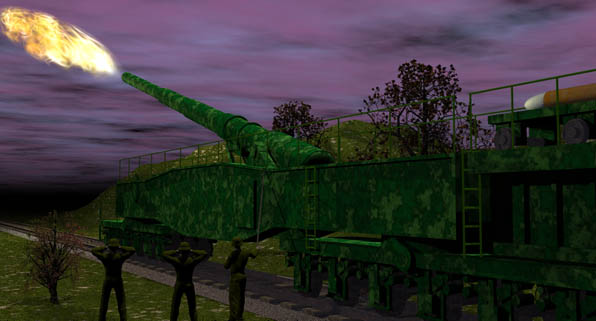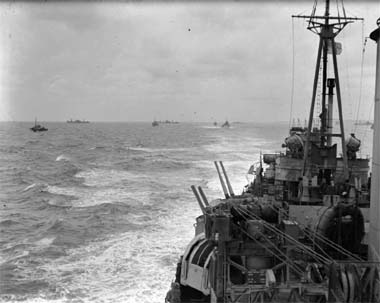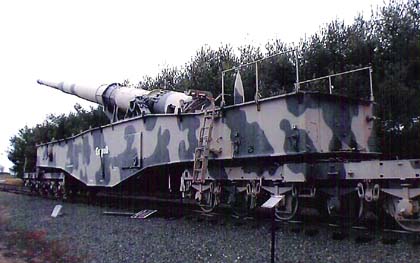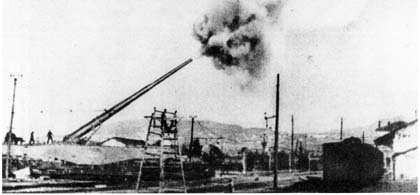Notes
from the Curator's Office
Anzio
Annie: The Gun that Held 50,000 Men Hostage
|

Leopold,
AKA "Anzio Annie," fires another shot into the
Allied beach head camp.   (Copyright
Lee Krystek, 2012) (Copyright
Lee Krystek, 2012)
|
(7/12) A number of years ago when I was employed
as a computer systems analyst, I had to make regular trips from
my office down to the NSA at Fort Meade near Washington. The
trip took nearly half a day, so to break the monotony I would
stop for a few minutes at the Ordinance Museum at the Aberdeen
Proving Grounds. In those relaxed days before 9/11, you could
pop off the exit from Interstate 95 and be in the museum's parking
lot in just 5 minutes. (I understand the museum has now moved
to a new location at Fort Lee, so before you visit, check its
website to find out its current status).
For anyone who was a history or military buff
the Ordinance Museum was a fascinating place. The indoor facilities
were in a small, brick building that housed an interesting collection
of small arms. It was the outdoor exhibits that were really
stunning, however. Row after row of tanks, mobile artillery,
bombs and rockets from around the world: German, Japanese, Russian,
British, Italian and, of course, American military hardware
were all represented. However, one exhibit, more than all the
others, couldn't help but catch the visitor's eye. Across the
street from the building was a massive German WWII gun mounted
on a pair of railroad cars. The sign next to it said it was
a 280mm (11 inch) gun that the Germans had dubbed "Leopold."
At the time I hadn't realized that this giant
had another name: Anzio Annie. It, along with its partner
(dubbed "Robert"), had terrorized Allied soldiers in 1944 as
they were penned in on a small Italian beachhead for over three
months. Only recently had I connected Annie's fascinating story
to the gargantuan gun I'd seen in Aberdeen.
The
Italian Campaign
|

The
British light cruiser HMS Mauritus of the Italian coast
during the Anzio landing.
|
Late in 1943, the Allies were pushing their way
north through Italy. They found themselves stopped by the "Gustav
Line," a defensive boundary created by the Germans south of
Rome. To out flank the Germans, it was decided to land two divisions
- one American and one British - at beaches near the towns of
Anzio and Nettuno. The Allies figured that the Germans would
be forced to divert troops to Anzio from the Gustav Line, allowing
a breakthrough there. If the Germans didn't divert troops, then
it was hoped that the Allied forces at Anzio could head inland
and cut the German supply lines to the Gustav instead.
After the landing, the Germans responded by rushing
forces to the Anzio/Nettuno area to hold the Allies from advancing
any further inland. In addition to troops and tanks their defense
included a lot of very large artillery.
The
Krupp K5-Es
The Germans had always loved big guns. During
WWI the famous German armament manufacturer, Kuipp, had built
huge a howitzer (a gun with a relatively short length for the
diameter of its barrel) with the nickname "Big Bertha." It could
toss a 16 ½ inch diameter, 1800 pound, shell almost eight miles.
Krupp also built the so-called "Paris Gun" which was used to
shell the city from March to August of 1918. While the Paris
gun had a relatively small shell - about 9 ½ inches wide and
weighing 210 pounds - its immense 92-foot-long barrel could
send its payload a staggering 81 miles.
Given their earlier experience, Krupp was tasked
by the German military in 1934 with the job of developing another
enormous gun. This one was to be mounted on a railcar and had
a barrel just over 70 feet in length. The gun was to be able
to handle shells weighing 560 pounds and send them a distance
of 40 miles. Krupp would build 25 of these monsters which were
designated with the model name "K5-E."
They were first employed during WWII along the
coast of France to harass shipping along the English Channel.
With their range, the guns stationed at Calais, France, could
also hit targets in Dover, England. Using special rocket-assisted
projectiles to increase the range, the Germans could even target
London.
When the battle at Anzio started, the German commander
General Albert Kesselring had "Leopold" and "Robert," two of
the K5-Es, sent by rail to a town named Ciampino. This location
was in the Albano hills about 19 miles from the Anzio beachhead.
|

The
"Paris Gun," with its 92 foot long barrel, needed
support cables to keep it from sagging.
|
The Americans had always doubted the value of
railway guns. After all they were, of course, limited to traveling
only where there was a railway line. A big gun like the K5-E
couldn't be aimed in just any direction, either. The front of
the railway car had to be pointed in the general direction of
the target. There were several ways of doing this. The easiest
was to find a section of curved track that was tangent to the
target and just position the gun where you needed it. A more
versatile solution, however, was to run the gun onto a turntable
so you could point it any direction you wanted. The Germans
designed a portable turntable just for this purpose .
The planned American reply to any enemy artillery
at Anzio was two-fold. The first was to use their own artillery
to return fire on the attackers and destroy them. The second
was to use the superiority they had in the air to hunt down
any guns giving them problems and bomb them into oblivion.
The
Tunnel
This wasn't going to be effective for the K5-Es
stationed at Ciampino, however. The range of the guns was far
beyond anything the Allies had, so there would be no return
artillery fire. Hunting them down and bombing them from the
air wasn't going to be easy either because the Germans had cleverly
located their firing position in the Ciampino railway yards
near a railway tunnel.
The man in charge of the guns, Colonel Frederik
Filzinger, ordered them parked in the tunnel anytime they were
not actually firing so they were well out of sight of any Allied
aircraft patrol. To further confuse things, the Germans also
built several dummy railway guns out of wood (apparently utilizing
a telephone pole mounted on a flat car). Painted and covered
with purposefully ineffective camouflage netting, these were
positioned to distract allied bombers from the true targets.
The Germans also set up flash simulators across the countryside
that at night would look like the muzzle flash of a cannon and
confuse the Allies further about the location of the big artillery.
Making things even more difficult for the defenders
were an array of other German artillery guns in the area. Most
of these were smaller, like the German 88mm, but a few, like
a captured battery of Czechoslovakian 210mm guns and a captured
battery of French 240mm guns, were much bigger and these could
have been mistaken for Leopold and Robert, though neither had
the range or the heavy payload of the K5-Es.
According to R.J. O'Rourke in his book Anzio
Annie: She was No Lady, German records show the K5-Es started
shelling the beach on February 7th, about two weeks after the
landings started. The typical routine for use of the guns was
to prepare them for operation as much as possible in the safety
of the tunnel. Then either "Robert" or "Leopold" along with
their support cars, would be pushed into the rail yard by a
diesel locomotive. The gun would be aimed at the approximate
position of the target and a special ranging shell, designed
to create a large black plume of smoke so it could be seen from
German observation posts overlooking the beach, would be fired.
While the round was still in the air, the gun's barrel would
be lowered, the breech opened and the remnants of the old shell
extracted. A cart on rails, which was already loaded with the
next shell and several bags of "diglycol" explosive powder,
was rolled up to the back of the gun and loaded into the barrel.
The Germans also put in a bag of Deuneberger salts to reduce
the muzzle flash and make it less visible. With the breech closed,
the weapon would be elevated again. By this time the observation
posts would be reporting back the location where the first shell
fell in relation to the final target and the position of the
gun could be adjusted. Then it would fire again.
|

The
K5-E dubbed "Leopold" parked at the Ordinance
Museum at Aberdeen. (Copyright Lee Krystek,
2005)
|
It took between four to seven minutes to reload
and fire the gun. This meant in a half-hour or so they could
fire six to eight rounds - usually enough to find and devastate
the target - and then the gun would disappear back into the
safety of the tunnel.
Though the Germans had other fairly large guns
at Anzio, these would constantly have to be relocated to avoid
being found and attacked by Allied forces. Each new location
would mean the guns would have to be re-oriented to beach head
with several rounds fired just to point them to the general
vicinity of possible targets. The tunnel gave the K5-E's the
advantage of always firing from the same location, which made
their shells deadly accurate.
The
Anzio Express
When the K5-E's first few rounds started hitting
the beach, the Americans quickly realized that railway guns
were not quite obsolete. The huge shells passing overhead sounded
like an express train and quickly gained the name "the Anzio
Express." The soldiers, not realizing there were actually two
guns involved, dubbed the cannon itself "Anzio Annie."
With the troops and all their supplies penned
into a relatively small area on the beach, targets were plentiful.
The big guns took out ammunition dumps, gasoline dumps, supply
dumps, and various harbor installations. Also under threat were
any ships that ventured close to land to unload. Because of
the threat posed by Robert and Leopold these had to be anchored
at least three miles out to sea, greatly hindering resupply
efforts.
Commanders on the beach demanded that Annie be
found and destroyed. Search planes were scheduled to overfly
the area every hour. Overcast weather and the tunnel kept the
secret of the Annies' location safe, however.
By March 3rd the guns had fired some 315 of their
huge rounds into the Allied camp. A few days later on March
8th, Captain Borchers, who was directly in control of the guns
operation, used intelligence gathered from aerial photos to
fire eight shells into what he thought looked like a fuel dump.
The result was a massive fire with flames that reached 1,000
feet in height. It burned for three days.
The
Allies Strike Back
|

One
of the Annies fires from the rail yard at Ciampino.
|
The next day the Allies believed they had gotten
a break. After some heavy shells hit the beach that morning,
an Allied plane spotted railroad guns firing from the Ciampino
yards. Eight P-40s carrying 500-pound-bombs were immediately
dispatched. They arrived over the target ten minutes before
noon to find the guns still in position. This was the first
of four air attacks against the guns that day. Dodging deadly
anti-aircraft fire the pilots dove on the target with bomb after
bomb exploding around or on top of them. By evening the Allies
were convinced that the "Anzio Express" had made its last run.
The news made its way quickly around the troops at the beach
head: Anzio Annie would not bother them again.
Unfortunately this wasn't the case. Leopold and
Robert had been safely parked in their tunnel several miles
away long before the first bomber arrived. The planes had attacked
the wooden decoys. Borchers' boss, Colonel Filzinger, later
called him after hearing the Allied radio announcement that
both of his guns had been destroyed, and told him laughingly
"You're dead!"
A few hours after the last plane was gone and
it was dark, Captain Borchers decided to dissuade the Allies
of the idea that Annie was gone by taking one of the guns out
and firing four more of the 280mm rounds into the Allied camp.
April came and the Allies were still stuck on
the beach with rounds from Annie and other German guns landing
on top of them day after day. The damage wasn't just in casualities
and destoryed supplies, either. The massive shells roaring overhead
were taking a huge psychological toll on the troops. A report
in Stars and Stripes described the situation:
"…the big guns arrived, and the beachhead troops
learned to recognize their gruesome, thundering scream. They
told how one shell split through three floors of a thick, stone
building beside the harbor. They told how another crashed through
an ancient Roman cave in Nettuno and how a third uprooted men
from their foxholes. A fourth ploughed into the Anzio cemetery
unburying the dead."
On April 6th the Allies finally got some luck.
One of Annie's shells proved to be a dud and punched an 18-inch
hole into the ground for a length of 47 feet. A crew dug down
to it and recovered the shell. Finally the Allies had a good
idea of what type of gun they were up against. However, inaccurate
intelligence about the K5-E's was still a problem. Some experts
estimated the range of these weapons was far more than they
actually were: perhaps sixty miles. This meant that the aircraft
searching for the guns now had a much larger area to cover.
The Allies best strategy turned out not to go
after the guns, but to bomb the rail lines and roads coming
into the region that carried the weapons ammunition. By the
beginning of May a shortage of shells and diglycol was forcing
Robert and Leopold to make fewer and fewer appearances.
The
Secret is Out
The secret of the tunnel was finally discovered
on May 28th. Several of the gun crew were sunning themselves
near the tunnel entrance when an Allied fighter plane suddenly
appeared. Though the guns were out of sight in the tunnel, some
of the crew ran towards the safety of the entrance. An experienced
sargent warned his men to stay put, some of the younger troops
panicked, giving away the secret.
Captain Borchers decided to expend half of his
remaining shells that night in case there was a successful attack
against the tunnel the next day. As he had feared, it came with
the dawn. Eight P-40s arrived, each carrying a 1000-pound bomb.
Though they struck near the tunnel entrance and destroyed the
gun crew's kitchen car, there was no damage to Leopold or Robert.
It was clear to Colonel Filzinger, however, with
the secret discovered, and with the advance of Allied troops
off the beach, he would have to either move the guns or lose
them. That night they fired off their last 16 rounds and the
gun train headed north. They had bombarded the beachhead for
almost four month,s doing massive amounts of damage to equipment
and supplies while terrorizing the British and American troops.
Unfortunately for the Germans there were no working
rail lines to the north for the guns to make their escape. It
was decided instead to take them to the port of Civiaveccia
in hopes that they could be removed on barges. These never came,
however, and the Germans were forced to render the guns unusable
and leave before Allied troops arrived.
Legacy
After the guns were captured, it was decided to
ship Leopold back to the states for examination and testing
at the Aberdeen Proving Grounds. The Army learned quite a bit
from this gun and used a similar design when they built the
M65 (nicknamed "Atomic Annie") the world's only cannon to fire
a nuclear weapon. Atomic Annie was the same caliber - 280mm
- as the K5-E. Like the K5-Es the gun's platform was supported
by two sets of rolling wheels. Instead of railroad cars, however,
the designers decided to use two truck-like transporters so
that the atomic weapon could be moved over regular roads.
Fortunately Atomic Annie, unlike Leopold, was
never fired in anger. Its one atomic test was conducted in 1953
in Nevada when it fired a 15-Kiloton warhead 7 miles. In total
it only spent a decade or so in the United States' arsenal before
military leaders decided that an atomic cannon, in the age of
jet bombers and ICBMs, was already obsolete.
Today, both an Atomic Annie and "Leopold"
are on exhibit at the Ordinance Museum. Leopold sits there quietly,
like the retired dinosaur it is. It is hard to believe the terror
this old metal monster once inspired, almost 70 years ago on
a beach half a world away.
A Partial
Bibliography
Anzio
Annie: She was No Lady by R.J. O'Rourke, O'Rourke Services
Co. 1995.
Anzio
Annie: The Story of a Gun by by Louis Wildenboer, Military
History Journal Vol 13 No 3 - June 2005.
Anzio
Annie makes her way to Fort Lee by F.M Wiggins, The Progress-Index,
2010.

Copyright Lee Krystek
2012. All Rights Reserved.